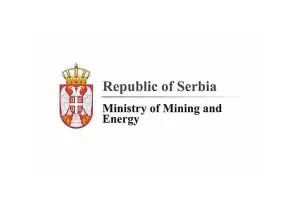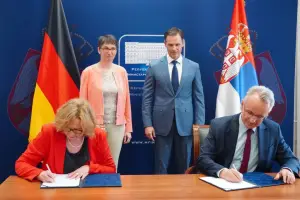- Serbia
Get to know Serbia
- Citizens
Culture and science
Health services
Pension and disability insurance
- Business
Employment
Economy
- Media
- Government
- Contact
Keep in touch
Contact form
Back
Keepin touch
Whether you have a question, comment, suggestion or any problem in the purview of the government, send us your message and we will try to respond as soon as possible. If your problem is not in our purview, we will forward your message to the relevant institution.
Q:
A:
January-March foreign trade falls
Belgrade,
30 April 2009
The Serbian Statistics Office said that Serbia’s total foreign trade for January-March 2009 amounted to $5,168 million, falling by 34.6% against the same period in 2008.
Exports totalled $1,666.8 million, decreasing by 33.5% from a year earlier, while imports fell by 35.2% to $3501.2 million.
Expressed in euros, exports decreased to €1,276.3 million, or by 23.8% against the same period in 2008.
Imports fell by 25.7% to €2,682.9 million against the same period in 2008.
The trade deficit was $1,834.4 million, a 36.6% decrease from the same period a year earlier.
Expressed in euros, the deficit was €1,406.6 million, or went down by 27.3% against the same period last year.
Exports-to-imports ratio was 47.6%, up from 46.4% from a year earlier.
The decreases in both imports and exports were due to the global financial crisis and reduced production.
Major exporters to Serbia were Germany ($194.5 million), Bosnia-Herzegovina ($188.4 million) and Italy ($179.1 million).
The largest importers from Serbia were Russia ($561.4 million), Germany ($398.3 million) and Italy ($320.6 million).
The greatest foreign trade was recorded in commerce with the EU, which accounted for more than half of total trade.
A foreign trade surplus was realised in commerce with Bosnia-Herzegovina, Macedonia and Montenegro.
The largest trade deficit was in commerce with Russia, due to the import of oil and gas.
The second most important partner was CEFTA countries, a surplus of $259.7 million being achieved mainly as a result of the export of agricultural products.
According to the Standard International Trade Classification, garments have the largest share of exports ($151 million), iron and steel ($133 million), cereals ($90 million), coloured metals ($85 million) and fruit and vegetables ($81 million). The exports in these five sections made up 32.4% of overall export.
Expressed in euros, exports decreased to €1,276.3 million, or by 23.8% against the same period in 2008.
Imports fell by 25.7% to €2,682.9 million against the same period in 2008.
The trade deficit was $1,834.4 million, a 36.6% decrease from the same period a year earlier.
Expressed in euros, the deficit was €1,406.6 million, or went down by 27.3% against the same period last year.
Exports-to-imports ratio was 47.6%, up from 46.4% from a year earlier.
The decreases in both imports and exports were due to the global financial crisis and reduced production.
Major exporters to Serbia were Germany ($194.5 million), Bosnia-Herzegovina ($188.4 million) and Italy ($179.1 million).
The largest importers from Serbia were Russia ($561.4 million), Germany ($398.3 million) and Italy ($320.6 million).
The greatest foreign trade was recorded in commerce with the EU, which accounted for more than half of total trade.
A foreign trade surplus was realised in commerce with Bosnia-Herzegovina, Macedonia and Montenegro.
The largest trade deficit was in commerce with Russia, due to the import of oil and gas.
The second most important partner was CEFTA countries, a surplus of $259.7 million being achieved mainly as a result of the export of agricultural products.
According to the Standard International Trade Classification, garments have the largest share of exports ($151 million), iron and steel ($133 million), cereals ($90 million), coloured metals ($85 million) and fruit and vegetables ($81 million). The exports in these five sections made up 32.4% of overall export.
-
 Belgrade, 11 August 2025
Belgrade, 11 August 2025Support for agricultural projects worth RSD 750 million
-
 Belgrade, 21 July 2025
Belgrade, 21 July 2025Construction of oil pipeline with Hungary to begin early next year
-
 Belgrade/Athens, 17 July 2025
Belgrade/Athens, 17 July 2025Serbia continues to align with EU in field of energy
-
 Kostolac, 14 July 2025
Kostolac, 14 July 2025First solar power plant Petka in Kostolac put into trial operation
-
 Belgrade, 11 July 2025
Belgrade, 11 July 2025Potential for improving cooperation with Belarus in many areas
-
 Požega, 5 July 2025
Požega, 5 July 2025Section of Pakovraće - Požega highway officially opened
-
 Belgrade, 2 July 2025
Belgrade, 2 July 2025Technical specifications defined for Serbia-Hungary oil pipeline
-
 Belgrade, 30 June 2025
Belgrade, 30 June 2025IMF confirms Serbia successfully implementing all agreed reforms
-
 Belgrade, 27 June 2025
Belgrade, 27 June 2025Double Taxation Avoidance Agreement with Germany signed
-
 Kostolac, 25 June 2025
Kostolac, 25 June 2025Construction of Kostolac wind farm nearing completion
